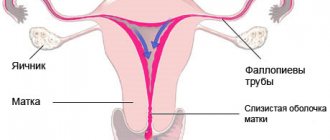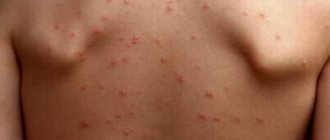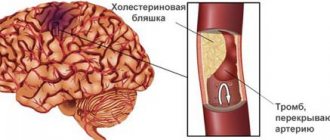Menarche, or the first period in girls, is an indicator of reproductive health and should occur at the time set by nature. The normal age for the onset of the first menstruation is adolescence. Harbingers of menstruation include aching, nagging pain in the lower abdomen and lower back, increased appetite, drowsiness, and irritability.
How to prepare a girl
Every attentive and caring mother will always notice changes in the life of her child. Menstruation occurs for the first time in the period from 10 to 16 years, and in rare cases, these periods can extend from 8 to 19 years. The early or late onset of menstruation can be influenced by a large number of reasons, but, in any case, the onset of menstruation will be preceded by changes in the girl’s appearance and her internal well-being. The duty of every mother of a daughter will be to mentally prepare the child for the onset of menstruation. It is necessary to explain what menstruation is, why it begins and what purpose it exists for.
The onset of menstruation is the main sign of the onset of puberty in adolescents. This is a kind of renewal of the female genital organs, which occurs every month in order to prepare the female body for a future pregnancy. With the onset of puberty, there is an intensive production of female hormones, which alternately change their concentration depending on the onset of the cycle. You should convince the child not to be afraid of these changes, and explain that this means a special growing up and “transformation” from a girl to a girl.
During this period, the figure changes, breasts grow, hair appears in places where there was none before, and problems of excessive gland activity are possible (sweating, dandruff and rapid contamination of the head, pimples and acne). The arrival of menstruation is often accompanied by malaise and abdominal pain; this must also be anticipated and stocked up on safe painkillers. The mother must explain all this clearly to her daughter, but before the conversation, be sure to familiarize yourself in detail with all the processes of the female body.
What determines the date of the appearance of menstruation?
There are many factors that influence when girls get their period. The main ones are the physical and physiological characteristics of the body. The normal age for the onset of menstruation is considered to be 11-16 years, but deviations up or down are possible.
Factors that may contribute to the shift in the first menstruation:
- hereditary characteristics;
- previous illnesses;
- weight;
- race;
- physical exercise;
- nutrition;
- emotional condition;
- lifestyle;
- pathologies or diseases in the body.
If a girl suffered a serious illness in early childhood and took medications for a long time, then menstruation may come later. Also, the reason for a delay in menstruation can be the child’s low body weight and thinness. The arrival of critical days too early, as well as the late arrival, is always influenced by hormonal levels or disturbances in the functioning of the reproductive system.
What should your first period be like?
When the pituitary gland and hypothalamus begin to produce follicle-stimulating and luteinizing hormones, the ovaries begin to function and the first menstruation begins. During this period, intensive development of the reproductive organs, maturation of eggs and growth of the endometrial layer in the uterus occurs. The first period is the beginning of menstrual cycles, which will occur regularly until menopause (45-50 years).
Menstrual bleeding is the shedding of the upper layer of the uterine lining, which occurs under the influence of hormones if fertilization has not occurred. During this period, dark red blood with a mucous consistency comes out of the genitals; its volume is about 50-100 ml. On the first day of bleeding, the discharge is not too heavy, and its peak occurs more often on the second day, after which the amount of blood released begins to decline. Critical days last individually, but must fit within a period of 3 to 8 days.
The very first periods may be shorter in duration and not too heavy. The first months after the start of menstruation, the cycle may be irregular, but later it becomes established, and the regularity of menstruation appears. Usually the cycle ranges from 28 to 35 days, but there are also deviations depending on individual characteristics and hormonal levels.
Signs that your first period is approaching
To prevent the onset of menstruation from becoming a surprise and misleading the girl, you should prepare her in advance and inform her about the upcoming changes. The first menstruation does not begin suddenly; it will always have preceding symptoms, which will manifest itself in the form of changes in the girl’s appearance, condition or behavior. An attentive parent will always notice these changes.
Signs of approaching menstruation in girls:
- breasts begin to grow;
- weight gain occurs;
- hair begins to grow on the pubic area, under the arms, on the legs and arms;
- whitish vaginal discharge;
- mood changes;
- intense secretion of glands (sweat, sebaceous);
- PMS in all its manifestations.
The listed signs may appear individually, or they may appear in combination. Almost all changes are associated with the beginning of the production of female sex hormones, which begin their intensive work in the body of a teenage girl. Immediately 1-2 days before the start of bleeding, the girl may experience discomfort in the lower abdomen and chest.
Hygiene products
The mother of a teenage girl should prepare the first hygiene products at the first signs of the end of puberty. That is, if the daughter is 11–12 years old, then a package of pads should be in the teenager’s closet.
Tampons should not be used at this age. The girl has no experience of behavior during menstruation or the skills of inserting a tampon. Due to inexperience, she may forget about this hygiene product in the vagina, which is fraught with the development of an inflammatory process.
When choosing gaskets, consider:
- Age
. You should not buy hygiene products designed for heavy discharge. For the first cycle, pads marked “Normal” or 2 drops are enough. Additionally, purchase a kit for use at night. Such pads are longer than regular ones and the risk of staining the bed linen is minimal. - Quality
. The girl should be comfortable. This must be a manufacturer tested by my mother. It is best to use ultra-fine products. They do not restrict movement and are invisible under clothing.
Before menstruation, the mother should check with her daughter about the availability of hygiene products. Despite the outward appearance of maturity or swagger, the teenager will be embarrassed to purchase pads for a long time.
How is the first menstruation and how to prepare the child
The duration and abundance of the first menstruation most often varies from person to person and manifests itself differently in everyone. Menstruation can last from 3 to 8 days, with the heaviest discharge in the first 2-3 days. The first and second days of menstruation are often accompanied by nagging pain in the lower abdomen, which is considered normal. After signs of approaching menstruation have been noticed, the girl should always have personal hygiene products and sanitary pads with her.
After the appearance of menstruation, the process of egg maturation begins, ovulation occurs, which means it becomes possible to become pregnant. You should explain to your child that the onset of menstruation means puberty, and talk about sexual relations and safe sex. It is important to familiarize your daughter with the rules of necessary hygiene during menstruation, since blood is a favorable environment for the development of pathogenic bacteria.
Is PMS normal or not?
Irritability, anxiety, and depressive symptoms before menstruation occur in approximately 30% of women. For 3-8% of women, PMS is a real disease that greatly affects the quality of life. PMS can and should be treated. A gynecologist-endocrinologist will recommend the necessary medications for you. In addition, PMS may be more pronounced in women suffering from anxiety and depression.
Early menstruation
Early menstruation is considered to be menstrual bleeding that begins before age 11. These periods can be considered normal if a girl has such a genetic trait in her family. In cases where premature menstruation is not associated with hereditary symptoms, you should contact a gynecologist to find out the cause of this anomaly.
Table of contents
- What is menstruation?
- When should a girl get her period?
- When does menopause occur?
- How long does a normal period last?
- Irregular periods - normal or not?
- How much blood do I lose during my period?
- What if I counted more than normal?
- What if, on the contrary, my periods are too scanty?
- Menstruation and contraception - how are they connected?
- If my period comes, does that mean I'm not pregnant?
- Is it normal to experience pain when your period arrives?
- Is PMS normal or not?
- How do periods affect my lifestyle?
- You can't get pregnant if you have sex during your period, right?
- I'm breastfeeding my two year old and I still haven't gotten my period.
- How to tell your daughter about your period?
Is a visit to a gynecologist necessary?
Girls experience their first menstruation at the young age of 11-15 years. The duration of the first bleeding can be from 3 to 7 days, and the profuseness is moderate or scanty. Critical days may be accompanied by slight malaise, nagging pain in the lower abdomen and tingling in the chest. In the first months, the cycle may not be established, and the arrival of critical days may be delayed. All of these signs are considered normal and do not require seeing a doctor. In cases where your period comes much earlier or later than expected, is accompanied by unpleasant symptoms and is of an atypical nature, you should seek help from a doctor.
When to visit a gynecologist:
- If subsequent periods do not come, and more than three months have passed since the end of the previous ones;
- Irregular cycle more than a year from the beginning of the first menstruation;
- Severe abdominal pain during menstruation;
- Very short duration of menstruation (1-2 days);
- Menstruation is too long (8-10 days);
- Menstrual flow is too heavy;
- Regulators have an unpleasant odor and foreign impurities.
For the convenience of monitoring the menstrual cycle, the girl is recommended to keep a diary and calendar, where she will note the first day of her period, its nature, abundance, duration and accompanying symptoms. The number of days from the first day of your period to the first day of your next period is considered the menstrual cycle, which on average ranges from 28 to 35 days. The menstrual cycle includes 3 phases, alternately replacing each other and responsible for the maturation of the egg. Every girl should know all this information in order to recognize abnormal symptoms and consult a doctor in a timely manner.
Menstruation is an inseparable part of every woman’s life, starting at a young age. Every girl should be aware of what it is and why it is needed. It will be the mother’s responsibility to have a friendly conversation with her daughter and mentally prepare her for the onset of her critical days.
What if I counted more?
If you menstruate more often than once every three weeks, or for more than 7 days, or more heavily than you should (more than 80 ml per menstrual cycle), you may not feel very well. Dizziness, weakness, and pallor can be a sign of both anemia and hidden iron deficiency. This does not always result in low hemoglobin. It happens that it is still normal, but iron deficiency already exists, and the woman suffers: she gets tired quickly, often cries and gets irritated, and feels apathy. Symptoms of iron deficiency can be similar to those of depression, and the two can often be confused.
If apathy and low mood are combined with extremely heavy menstruation, try taking a clinical blood test and ferritin. The norm for women over 15 years of age is from 10 to 120 mcg per liter, and the hemoglobin level is 120-145 g/l. If your hemoglobin or ferritin is low, you should consult a physician to prescribe iron supplements.
BACK TO CONTENTS










